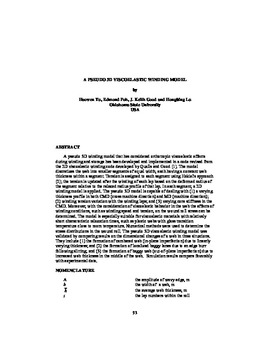| dc.contributor.author | Yu, Haowen | |
| dc.contributor.author | Poh, Edmond | |
| dc.contributor.author | Good, J. K. | |
| dc.contributor.author | Lu, Hongbing | |
| dc.contributor.other | International Conference on Web Handling (2007) | |
| dc.date.accessioned | 2019-11-11T16:19:54Z | |
| dc.date.available | 2019-11-11T16:19:54Z | |
| dc.date.issued | 2007-06 | |
| dc.identifier | oksd_icwh_2007_yu | |
| dc.identifier.citation | Yu, H., Poh, E., Good, J. K., & Lu, H. (2007, June). A pseudo 3D viscoelastic winding model. Paper presented at the Ninth International Conference on Web Handling (IWEB), Stillwater, OK. | |
| dc.identifier.uri | https://hdl.handle.net/11244/321927 | |
| dc.description.abstract | A pseudo 3D winding model that has considered orthotropic viscoelastic effects during winding and storage has been developed and implemented in a code revised from the 2D viscoelastic winding code developed by Qualls and Good [1]. The model discretizes the web into smaller segments of equal width, each having a constant web thickness within a segment. Tension is assigned to each segment using Hakiel's approach [2]; the tension is updated after the winding of each lap based on the deformed radius of the segment relative to the relaxed radius profile of that lap. In each segment, a 2D winding model is applied. The pseudo 3D model is capable of dealing with (1) a varying thickness profile in both CMD (cross machine direction) and MD (machine direction); (2) winding tension variation with the winding laps; and (3) varying core stiffness in the CMD. Moreover, with the consideration of viscoelastic behavior in the web the effects of winding conditions, such as winding speed and tension, on the wound roll stress can be determined. The model is especially suitable for viscoelastic materials with relatively short characteristic relaxation times, such as plastic webs with glass transition temperature close to room temperature. Numerical methods were used to determine the stress distributions in the wound roll. The pseudo 3D viscoelastic winding model was validated by comparing results on the dimensional changes of a web in three situations. They include (1) the formation of cambered web (in-plane imperfection) due to linearly varying thickness; and (2) the formation of localized baggy lanes due to an edge burr following slitting; and (3) the formation of baggy web (out-of-plane imperfection) due to increased web thickness in the middle of the web. Simulation results compare favorably with experimental data. | |
| dc.format | application/pdf | |
| dc.language | en_US | |
| dc.publisher | Oklahoma State University | |
| dc.rights | In the Oklahoma State University Library's institutional repository this paper is made available through the open access principles and the terms of agreement/consent between the author(s) and the publisher. The permission policy on the use, reproduction or distribution of the article falls under fair use for educational, scholarship, and research purposes. Contact Digital Resources and Discovery Services at lib-dls@okstate.edu or 405-744-9161 for further information. | |
| dc.title | Pseudo 3D viscoelastic winding model | |
| osu.filename | oksd_icwh_2007_yu.pdf | |
| dc.description.department | Mechanical and Aerospace Engineering | |
| dc.type.genre | Conference proceedings | |
| dc.type.material | Text | |
